|
|
Hyperion

|
|
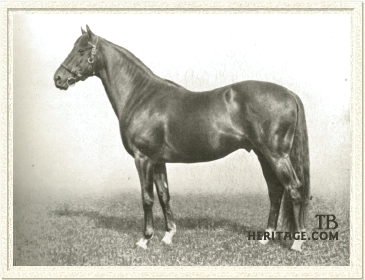 |
|
|
Hyperion is considered one of the most important thoroughbreds of the Twentieth Century, both as a runner and as a sire. A genuine crack on the racecourse, he sired numerous classic winners, leading sires around the world, and top broodmares, making him one of the most influential sires of all time.
Hyperion was bred by Lord Derby, who also bred his dam Selene, and granddam, Serenissima. Foaled on April 18, 1930 at Side Hill Stud, Newmarket, England, his conception was remarkable in itself, since Selene had been barren in 1928, and was late coming into heat in 1929. She was sent to Harwood Stud in Berkshire to be bred to Gainsborough, but failing to cycle, considerations were being made to send her back to Newmarket without a cover. Fortunately, she caught on a mid-May breeding, and the foal to result was Hyperion.
Gainsborough was bred by Lady James Douglas. He was by the St. Leger and Ascot Gold Cup winner Bayardo, out of Oaks winner Rosedrop. Gainsborough ran true to his classic pedigree and won the English Triple Crown of 1918, making his breeder the first woman to own the winner of the Derby Stakes (albeit the substitute event run at Newmarket due to the war). Gainsborough retired to stud at Harwood in 1920. The stud, including Gainsborough, was sold to Herbert Blagrave upon the death of Lady Douglas in 1941. Gainsborough remained there until his death in 1945 at the age of 30. He was buried there, and the property now carries his name, Gainsborough Stud.
Gainsborough was the leading sire in Great Britain twice, in 1932 and 1933. He is considered a source of great stamina, and besides Hyperion, his best offspring included Solario (St. Leger, Ascot Gold Cup; leading sire in 1937), Singapore (St. Leger), Orwell (2,000 Guineas), Tournesol, Goyescas, and the mares Mah Mahal (dam of Derby winner and leading sire Mahu), Una Cameron (dam of 2,000 Guineas winner Cameronian), and Painted Vale (dam of 1,000 Guineas and Oaks winner Musidora).
Gainsborough's colt of 1930 out of Selene, a mare named for a moon goddess, was called Hyperion, after a Greek sun god. He was little, not unusual considering that Selene was small, and Gainsborough just above average in height. He was also inbred 4x3 to St. Simon, who was also not a large horse. But the Selene colt was further described as "weakly" and too small to take his grain with the other foals, so a feed bunker was custom made to accomodate him. There was also some thought given to having the little fellow gelded, sold as a cull, or even destroyed.
Hyperion was weaned late and not being of the most robust constitution, was left at Side Hill Stud when the rest of the foal crop were sent off to Knowsley, near Liverpool. By coincidence, Selene's dam Serenissima had also produced a small, late foal that year, El Capitan, a colt by Colorado, who was likewise left to keep Hyperion company in Newmarket.
Spared the stress of shipping, the two backward colts were allowed to grow up together. El Capitan disappeared from the records without distinction, but as Roger Mortimer describes in "Twenty Great Horses of the British Turf," trainer George Lambton "decided to take a chance with [Hyperion], being impressed with his beautiful action and by his head, so full of character and courage." According to Lord Derby, the trainer had already fallen in love with the Selene colt as a yearling "remarking that he was the most beautifully made little horse he had ever seen and would undoubtedly win the Pony Derby."
Hyperion barely topped 15 hands when he went into training and matured at just 15.1 1/2 hands. He inherited the short legs of his female line, but was lengthy and powerfully built both fore and aft. He girthed 67 inches, with a cannon bone circumference of 7 1/2 inches. Hyperion was a burnished chestnut, changing colors in different seasons and quality of light. In a sweat, he was dark, but his mane and tail tended to be lighter than his body color. Although there was no white on his face, Hyperion had four white feet, supposedly a bad combination according to folk lore, white pasterns in front and white just over the ankles behind.
Hyperion on the Turf
At two, Palmer described him as "a short-legged, light-boned colt, with the muscling of a wrestler, but also very high-headed and ewe-necked." The Gainsborough colt had a long skull with a straight profile. He also had somewhat straight shoulders, low withers, and a level croup with the tail set on high. This long, level build has been a trademark of the Hyperion line for many generations, appearing quite distinctly in descendants such as Alibhai, Star Kingdom, Noholme II, and Nodouble.
Hyperion was equally blessed and plagued with a very sedate disposition. He was lazy to the extreme, and had to be worked hard to be made fit. Lambton doted on him, perhaps seeing the same promise in him as he did in the great Swynford, half-brother to Selene's sire Chaucer. The colt was allowed to stop and go as he pleased on the gallops or in the yard.
Lambton had Hyperion ready for his racing debut in May at Doncaster and the new environs made the colt came alive in the afternoon, displaying the racing attitude he lacked in the morning at Newmarket, where he had spent his entire life. Still, he ran just a creditable fourth against 18 others in the Zetland Maiden Plate, won by Aidetta. But in his second start, Hyperion won the New Stakes (5f. Ascot) trouncing Nun's Veil and 20 others by three lengths, breaking the course record in the process.
Next time out in the Prince of Wale's Stakes (6f. Goodwood), the filly Nancy Stair ran Hyperion to a dead-heat over a heavy course. In the Boscawen Post Stakes (5f. Newmarket) in October, he was third to the brilliant Manitoba, beating one other horse in the small field. In the Dewhurst Stakes (7f. Newmarket), he won easily, by two lengths over a heavy course. On the Free Handicap, Hyperion was rated fourth at 126, with Manitoba (127) the top weighted colt behind the fillies Myrobella (133), Betty (129) and Brown Betty (128).
At three, Hyperion had matured, but had barely gained in stature. He remained disappointing in his works, consistently beaten by stablemate Scarlet Tiger in the morning. Due to his size, Hyperion had not been nominated to the 2,000 Guineas, so he debuted in May in the Chester Vase (12f. Chester). Starting off sluggishly, jockey Weston had to shake him up, the response being that Hyperion rushed to the front and won by two lengths from Shamsuddin and Franz Hals.
Starting favorite in the Derby (12f. Epsom), the ease of his victory over King Salmon and Statesman was astonishing. Credited at four lengths, it was probably a wider margin, but even more impressive was his time of 2:34, a new Derby record. It gave his owner a second win in the event named for his family, and made little Hyperion something of a public idol.
In the Prince of Wale's Stakes (13f. Royal Ascot), Hyperion carried 131 pounds on soft going to a two-length win over Shamsuddin (115 pounds). He had problems maintaining a training schedule, having dislocated his patella (knee cap) on more than one occasion, and a badly timed recurrence of the injury made a prep race prior to the St. Leger impossible, so he went into the big race off a three month layoff. In the final classic, he romped home again, leading almost from the start, beating the high class colt Felicitation by three easy lengths, with Scarlet Tiger third, and King Salmon fourth.
Lambton and Lord Derby severed their successful owner-trainer relationship after the 1933 season, when Derby suggested that Lambton name a successor due to his age and failing health. Lambton left in a huff and continued training for others until his death eleven years later. Colledge Leader took over the management of Hyperion, being filled in by his predecessor on the lazy colt's habits and need for hard work.
Under the new management, Hyperion won his four-year-old debut in the March Stakes (10f. Newmarket), carrying 138 pounds, by a neck from Angelico (118), with Felicitation third (132). Then came the Burwell Stakes (12f. Newmarket), in which he defeated King Salmon by three quarters of a length at level weights (136).
Extremely firm ground caused Hyperion to scratch from the Coronation Cup, and in a two mile gallop prepping for the Ascot Gold Cup, he had to be pulled up, unfit for the distance. In the parade ring prior to the Gold Cup, Hyperion spotted Lambton, wheelchair bound, and in a remarkable display of affection, stopped dead in front of his former trainer, refusing to move on for some time.
For the two and a half mile Ascot Gold Cup itself, a downpour turned the course into a quagmire and Felicitation won by eight lengths, with Thor II ahead of a tiring Hyperion by one and a half lengths. His next start was the Dullingham Stakes (12f. Newmarket), and with only two horses going to the post, Hyperion (142 pounds) ran second to three-year-old Caithness (113) by a short head in an intense stretch battle.
The little colt was retired after this, leaving owner and fans deeply disappointed, but he had accumulated a record of nine wins in thirteen starts, with one second, two thirds and only once unplaced (in his debut at two).
How good was Hyperion? Although a pet of Lambton's, he did not rank him as high as Swynford ("I knew to a pound how good Hyperion was. I never knew how good Sywnford was."), nor apparently as high as Fairway.
Hyperion at Stud
Hyperion entered the stallion ranks in 1935 at Lord Derby's Woodland Stud, where he spent most of his remaining life. During World War II, after the breeding season, he was moved to Thornton Stud in the "wilds" of Yorkshire, far north and out of the line of enemy fire, since Newmarket, surrounded by airfields, was a likelier target for enemy bombers. He also stood three seasons at Derby's Plantation Stud, likewise in Newmarket.
As a stallion, Hyperion was one of the greatest of all time. He was the Leading Sire six times, in 1940, 1941, 1942, 1945, 1946, and 1955; also second four times, in 1939, 1944, 1950 and 1952, and third once, in 1943. He sired 527 foals, of which 118 won stakes including seven winners of eleven English classics, as well as Kentucky Derby/Preakness winner Pensive in the U.S. |
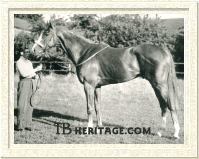
Aureole
| |
Hyperion's leading earner was AUREOLE (ch.c. 1950-1974 out of Angelola by Donatello II). Bred by His Majesty King George VI, and the first foal out of his dam, Aureole raced for his breeder's daughter, Queen Elizabeth II. This royal connection made him a public favorite. Aureole won seven races from two to four. At two, he won the Acomb Maiden Stakes at York, but was unplaced in the Middle Park Stakes, his only other start of the year. At three, he was second only to Pinza, with wins in the Lingfield Derby Trial and Cumberland Lodge Stakes, with seconds in the Derby and King George VI and Queen Elizabeth Stakes (both to Pinza), and third in the Eclipse and St. Leger. |
|
Fiery Aureole, a middle weight at 16 hands, was a flashy bright chestnut with a broad blaze and three stockings. Although lacking refinement and with slightly faulty hocks typical of his sire's progeny, Aureole became the Leading Sire in Great Britain in 1960 and 1961, the only son of Hyperion to do so on his home turf. At stud, he got St. Paddy (Derby, St. Leger, etc.), Saint Crespin (Prix de l'Arc de Triomphe, Eclipse S.), Aurelius (St. Leger), Miralgo (Hardwicke Stakes), Aurabella (Irish Oaks), and Vienna (sire of Vaguely Noble). |
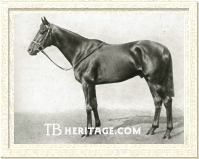
Owen Tudor
| |
Hyperion's son OWEN TUDOR (br.c. 1938-1966 out of Mary Tudor II by Pharos) was bred by Mrs. R. Macdonald-Buchanan. His dam was a high class racemare who won the Poule d'Essai des Pouliches (French 1,000 Guineas), Prix Vermeille, and Prix Chloe, and was second in the Prix de Diane (French Oaks), and her dam, Anna Bolena had also won the Poule d'Essai des Pouliches. Trained by Fred Darling, Owen Tudor's race record featured six wins in thirteen starts. At two, he won the Salisbury Stakes in his first start, was second in the Boscawen Stakes, and was rated among the top eight juveniles of the year on the Free Handicap. At three, he ran seven times and won the New Derby Stakes (the wartime substitute run at Newmarket), Newmarket St. Leger, and Column Stakes. At four, Owen Tudor won the Gold Cup (run that year at Newmarket, instead of Ascot due to wartime restrictions). |
|
A leggy brown horse with no white markings, Owen Tudor had the length and depth of Hyperion, and had slightly bent hocks. His record as a sire was impressive, although his highest ranking was once being second on the French sires' list, in 1961, when Right Royal V was a three-year-old. He sired the brilliant miler Tudor Minstrel (2,000 Guineas), the great sprinter Abernant (Middle Park Stakes, July Cup, King's Stand Stakes), and more typical stayers in Right Royal V (French Derby, French 2,000 Guineas, King George VI and Queen Elizabeth Stakes), Theodorica (Italian Oaks in 1955), Eplenor (Ascot Gold Cup, Prix du Cadran), and Tudor Era (in the U.S., Man o'War Stakes, DQ from first in the Washington D.C. International). Tudor Minstrel and Abernant became important sires and carried the male line forward with brilliant speed. |
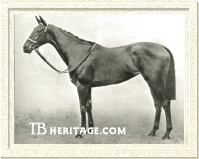
Sun Chariot
| |
SUN CHARIOT (br.f. 1939 out of Clarence by Diligence) was bred in Ireland by the National Stud and was leased to King George VI for racing. A brilliant but moody, sometimes erratic filly, she showed little in early preparations and was nearly retired unraced, but just in time, turned a corner mentally and there was no looking back. Undefeated in four starts including the Queen Mary and Middle Park Stakes (beating colts handily in the latter), she topped the Free Handicap at two over stablemate Big Game and Watling Street. At three, she was third in her debut, her only career loss in nine starts, and won the Sarum Stakes, 1,000 Guineas, Oaks, and St. Leger. In the Oaks, she caused three false starts, then at the final break, bolted in the wrong direction, but still managed to win the classic by a length. |
|
As a broodmare at Sandley Stud, she produced 4 stakes winners from 11 foals before her death in 1963. These included Blue Train (1944 c. by Blue Peter), Gigantic (1946 c. by Big Game), Landau (1951 c. by Dante), and Pindari (1956 c. by Pinza). Blue Train got an Irish Oaks winner before he went sterile, was sent back in training, and broke down, having to be destroyed. Gigantic went on to a successful stud career in New Zealand, while Landau did the same in Australia. Pindari was also useful in Great Britain before export to India. |
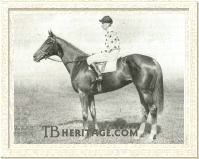
Hycilla
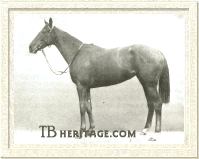
Sun Stream
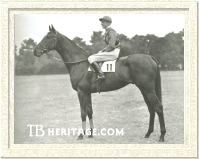
Sun Castle
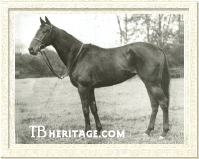
Hypericum
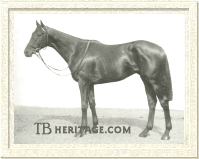
Gulf Stream
| |
GODIVA (b.f. 1937 out of Carpet Slipper by Phalaris) was bred by Esmond Harmsworth, in whose silks she ran. One of the best of her age at two, at three, she won the New 1,000 Guineas and New Oaks, the latter run at during World War II. Her run in the Oaks was brilliant, winning by three lengths under apprentice Douglas Marks, who turned in his saddle and urged the other riders to "come on!" after he passed. Her time bested that of the colts in the New Derby, won by Pont l'Eveque the day before, stamping her as probably the best of her crop, colt or filly. That was her final start. Tragically, she was destroyed after contracting septicemia at Fort Union Stud in Ireland later that year.
HYCILLA (ch.f. 1941 out of Priscilla Carter by *Omar Khayyam) was bred in Ireland by William Woodward, out of an American-bred mare whose pedigree made her ineligible for the General Stud Book and listed as a "half-bred." Despite this, she won the Oaks and Champion Stakes in 1944, although beat herself by pulling hard in the St. Leger, in which she was unplaced. Retired to stud in America, she produced four minor winners. Her only daughter from five foals, Heraclesia (1947 by Fighting Fox), produced four colts, one winner, and so her female line came to a staggered end.
SUN STREAM (ch.f. 1942 out of Drift by Swynford) was bred by Lord Derby and a younger sister to the good colt *Heliopolis. Winner of the Queen Mary Stakes at two, she won the 1,000 Guineas, and was second in the Oaks by a head to Naishapur. As a broodmare she produced four winners led by Liverpool St. Leger winner Herculaneum (1951 by Donatello II), who went to stud in South Africa and was the dam's sire of champion Bold Tropic. Daughter Riviera (1954 by Nearco) was a stakes winner at two. Sun Stream's stakes-placed Western Sky II (1957 by Never Say Die) came to stand in the U.S. and sired two stakes winners before being passed along to Venezuela in his old age.
SUN CASTLE (b.c. 1938 out of Castle Gay by Buchan) was bred by Lady Chesterfield. Third in the 2,000 Guineas behind Lambert Simnel and unlaced in the Derby, he won the St. Leger, or rather, a war-time substitute run at Manchester in which he defeated Owen Tudor. Kept in training, he developed tetanus and was euthanized shortly thereafter.
HYPERICUM (b.f. 1943 out of Feola by Friar Marcus) was bred at the Royal Stud and raced by King George VI. Winner of the Dewhurst Stakes at two, she was also second to Khaled in the Middle Park Stakes that year. Second in her season debut to Neolight, she held up the start of the 1,000 Guineas by her antics. She lost her rider and ran off before finally being caught, remounted and sent off for the race, which she won handily, beating Neolight by a length and a half. She ran fourth in the Oaks after more temperamental displays at the start, and was again unplaced in the Coronation Stakes, after which she was retired. She produced the good stakes winner Restoration (1955 by Persian Gulf) and stakes placed fillies Belladonna and Highlight, the latter becoming a major broodmare for the Royal Stud producing, among others, Highclere (dam of the great broodmare Height of Fashion).
|
Hyperion's other champions in Europe included Irish St. Leger winner OMMEYAD, champion two-year-old GULF STREAM, and two-year-old filly OPALINE II.
In 1940, Arthur Hancock went to England and purchased the broodmare *Penicuik II, who was in foal to Hyperion at the time. Brought to Kentucky with her Hyperion weanling *Hyperionian (later stakes-placed at two) at foot, she was sold to Calumet Farm owner Warren Wright, and at his farm, foaled a chestnut colt named PENSIVE (ch.c. 1941 out of *Penicuik II by Buchan). Stakes-placed at two, the Calumet colt became the farm's second Kentucky Derby and Preakness winner in 1944, losing the Belmont Stakes that year to Bounding Home, and the division title to the stayer By Jimminy. Retired to stud at Calumet as a four-year-old in 1945, Pensive made only four breeding seasons before his death in May of 1949 at the age of eight.
Although short-lived, Pensive was an outstanding sire, getting six stakes winners from 53 foals including Kentucky Derby winner Ponder ($541,275) from his first crop, also the speedy colts Cyclotron ($151,912) and Theory ($71,920), and the filly Wondring (Ashland Stakes). His daughter Fairy Flax was sent to race in England and proved an exceptional sprinter at four, winning the King's Stand Stakes.
Pensive is noted as the first sire in a unique sireline triple play, getting a fellow Kentucky Derby winner in Ponder in his first crop, and Ponder's first crop also included a Kentucky Derby winner in Needles. |
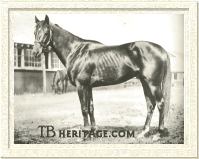
Pensive
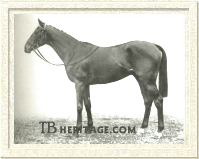
Heliopolis
| |
Pensive wasn't the only important son of Hyperion to meet with success as a stallion in North America, and he certainly wasn't the best. The trio of Heliopolis, Khaled, and Alibhai all exceeded him as sires in quality and quantity.
Lord Derby's homebred HELIOPOLIS (br.c. 1936-1959 out of Drift by Swynford) was from the first crop sired by Hyperion, and a half-brother to the 1,000 Guineas winner Tide-Way. He was inbred 4x3 to the Derby mare Canterbury Pilgrim through her sons Chaucer (dam's sire of Hyperion) and Swynford. At 2, Heliopolis started four times, with his only win in the Imperial Produce Stakes (Kempton) beating Casanova and Admiral's Walk, also sons of Hyperion. He was also second in the Prince of Wales' Plate, and third in the Champagne Stakes, earning a ranking among the top ten colts of the crop, led by Panorama and Blue Peter. At three, he won the Chester Vase (12f.), Prince of Wales Stake (13f.), Princess of Wales' Stakes (12f.), Gratwicke Produce Stakes (12f.), and was third in the Derby (to Blue Peter, Fox Cub). At four, his best effort in three starts was a second in the Stonehenge Plate. Sold to American Charles B. Shaffer for $20,000, Heliopolis ran once at five at Hialeah, fifth against four other runners at Hialeah in an allowance race. He closed out his career with 15 starts, five wins, and although short of top class, had proven well up to classic distances, if not the competition. |
A brown horse with plain head set off by a large snip on his nose, and both hind feet white (a fetlock on the right and a coronet on the left). He was a lengthy horse with tremendous hindquarters and a somewhat upright shoulder, giving him the appearance of having a dip in his back. Heliopolis entered stud at Shaffer's Coldstream Stud in Kentucky, where he worked out well with the native mares getting both speed and stamina, and was the Leading Sire in the U.S. in 1950 and 1954. He sired 53 stakes winners including the champions High Gun (at three, Belmont Stakes), Parlo, Aunt Jinny (two-year-old filly), Grecian Queen, Berlo, Summer Tan (highweighted two-year-old, although not champion), Olympia (sprinter), Helioscope, Globemaster, Greek Ship, Greek Song, Ace Admiral. In 1951, Shaffer sold Coldstream to Henry Knight, who also purchased and syndicated Heliopolis, and moved him to Almahurst Farm in Nicholasville, Kentucky. There he died in 1959, aged 23 years old, destroyed due to laminitis.
KHALED (b.c. 1943-1968 out of Eclair by Ethnarch) was bred by the Aga Khan and Prince Aly Khan, the father-son team having purchased his dam in foal to Hyperion at the 1942 December sales at Newmarket from breeder Marshall Field. Eclair, a top class filly, was the only important horse by her sire, the handicapper Ethnarch. Khaled was undefeated at two in three tries, including victories in the Coventry Stakes and Middle Park Stakes, but was still only rated sixth among his division on the Free Handicap. At three, he proved not up to classic competition. He started with a win in the Column Produce Stakes (7f. Newmarket), but he had begun to make a noise while breathing, suggesting he had become a roarer. He was second in the 2,000 Guineas, but unplaced in the Derby (won by Airborne). He bounced back with a win in the St. James' Palace Stakes, then ran third in the Eclipse Stakes (10f. Ascot) to Gulf Stream and Edward Tudor.
Broken in his wind, Khaled was retired to stud in Ireland, and made his four-year-old season there before being purchased by Rex Ellsworth for $160,000. Ellsworth put him back in training and the horse won an allowance race at Santa Anita in January of his five-year-old year from three starts. He stood the breeding season, then went back in training, but was unplaced (last) in a race in late December and finally retired for good at Ellsworth's ranch in California. A solid bay with no white markings, he was shorter backed than most Hyperions, but nicely balanced, thickset, with powerful quarters and a comparatively straight hind leg, showing some influence of The Tetrarch.
|
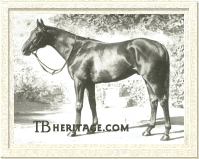
Khaled
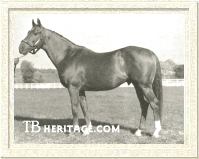
Alibhai
| |
Khaled's first crop in Ireland (foals of 1948) produced little besides stakes-placed Dulac, but his first American crops sizzled with precocious speed and class. His 61 stakes winners were led by the great Swaps (1952), a giant of a horse who beat Nashua in the Kentucky Derby, and was the champion handicapper the following year, setting or equaling eight track, American or World records in three years of racing. Khaled's other top class runners included handicapper Terrang, the C.C.A. Oaks winner A Glitter, world record sprinter El Drag, Correspondent, California Kid, Candy Dish, Corn Off the Cob, Hillary, New Policy, Linmold, and numerous others. Swaps, Hillary, New Policy, and a few others were useful stallions, but Khaled's daughters were better broodmares, and included Swaps's sister Track Medal (1962 Broodmare of the Year), Candy Dish (dam of Preakness winner Candy Spots), and Bushel-N-Peck (dam of the leading sire Wild Again).
Hyperion's son ALIBHAI (ch.c. 1938-1960 out of Teresina by Tracery) was also bred by the Aga Khan and is notable for being one of the few successful stallions of the modern era who was unraced. Purchased by movie magnate Louis B. Mayer as a yearling from the breeder for 3,200 guineas, he was a younger half-brother to Gino, who had been a useful sire in Virginia for W.S. Kilmer. Alibhai was imported to the U.S. as a yearling and put in training, but bowed both front tendons and never started. He was put to stud as a three-year-old in 1941 at Mayer's farm in California and was an immediate success. Syndicated and moved to Kentucky for the 1947 season at Spendthrift Farm, he died there in 1960 at the age of 22.
|
Alibhai was more similar in type to his sire than any of the previous sons mentioned. A light chestnut with a small star and three white feet, he was very long bodied, muscular, with a cresty neck, and a noticeably dipped back. He had a long forearm but was extremely light of bone below the knee, the probably reason for his bowing.
In all, Alibhai sired 54 stakes winners, led by the champion two- and three-year-old filly Bowl of Flowers, from his last crop, foals of 1961. He also sired Kentucky Derby winner Determine, champion handicap mare Bornastar, and another top filly in Flower Bowl. Alibhai's good sons included the good handicappers Bardstown, Traffic Judge, On Trust, Solidarity, Chevation, Sharpsburg, Cover Up, Honeys Alibi, Mr. Consistency and the classy Your Host.
Alibhai's sons included several good sires such as Your Host (sire of the great Kelso) and his brother My Host, Traffic Judge (sire of Delta Judge, Traffic, Traffic Cop, etc.), and Honeys Alibi (dam's sire of the great mare Dahlia). His daughters included Flower Bowl (dam of Graustark and Ribot), Bowl of Flowers (dam of sires Big Burn and Whiskey Road), Lurline B. (dam of Lurullah, Roman Line, etc.), and Your Hostess.
Other sons of Hyperion that were good sires in the U.S. included Gun Shot (sire of Gun Bow), Half Crown (sire of Tempted), Hypnotist II, Zenith, and Radiotherapy. |
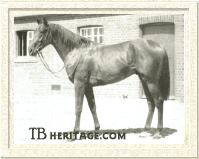
Aristophanes 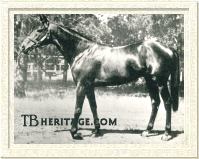
Helios broke his pastern and was fitted with a steel bar
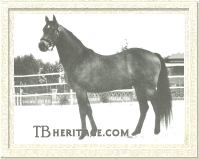
Deimos, twice leading sire in South Africa
| |
Hyperion became a vastly important sire of sires on an international level beyond England and the U.S.
In Great Britain, besides Owen Tudor and Aureole, there were ROCKEFELLA (sire of 2,000 Guineas winner Rockavon), HIGH HAT (sire of 1,000 Guineas winner Glad Rags and sire High Line), HORNBEAM (sire of St. Leger winner Intermezzo, and the broodmares La Milo, Windmill Girl, and Hornpipe II), STARDUST (sire of Star King, renamed Star Kingdom), and ADMIRAL'S WALK (sire of Sybil's Niece).
He also sired ALDIS LAMP (leading sire in Belgium), COASTAL TRAFFIC (Buisson d'Or, in France), BABU'S PET (in France), HYPERBOLE (leading sire in Sweden),
In South America, Hyperion's successful sons included champion English two-year-old GULF STREAM (sire of Gulf-Weed, Montparnasse II), SELIM HASSAN (Yatasto), QUICK RAY and ARISTOPHANES (Forli, Atlas, Dorileo).
In Australia, his top sons included HELIOS (Leading sire 1949), RED MARS, HIGH PEAK, EMPYREAN, and it would be an oversight not to mention his grandson, Irish-bred STAR KINGDOM, by Stardust, leading sire five times in Australia).
In New Zealand, his sire sons included RUTHLESS (leading sire twice), ROLLED GOLD, and SUN KING. In South Africa there was DEIMOS (leading sire twice). |
|
This reputation as one of the greatest sire of sires of all time does not diminish Hyperion's influence as a broodmare sire, however. He was the leading broodmare sire in Great Britain in 1948 and 1957, and was five times second. His great producing daughters include Aurora (dam of Alycidon, Borealis, Acropolis, and Agricola), Hydroplane II (dam of American great Citation), Lady Angela (dam of Canadian champion and leading sire Nearctic), Calash (dam of Oaks winner Calash and Argentine sire Snow Cat), Barley Corn (dam of Shantung, Dame d'Atour), Libra (dam of St. Leger winners Ribocco and Ribero), Lightning (dam of Parthia, Electric Flash), Neutron (dam of Court Harwell, leading sire in England of 1965 and Meadow Court), Suncourt (dam of Tesco Boy, leading sire in Japan), Helia (dam of Ascot Gold Cup winner Supertello), Imitation (dam of Pretense), Red Ray (granddam of Mill Reef), Run Honey, and Sun Helmet. |
| 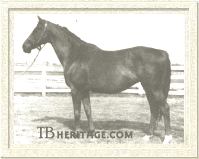
| | 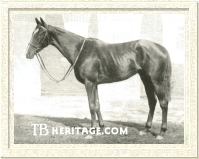
| |
| 
| |
Top Left: Hydroplane II
Top Right: Lady Angela
Bottom Left: Lightning | |
Much of the success of Hyperion's sons and daughters were the result of a fortuitous nick with his great stallion contemporary Nearco. The Canadian horse Nearctic is a prime example, a champion and leading sire, and most notably the sire of Northern Dancer.
Hyperion lived out his long life as a leading sire, but almost always exhibited a laid-back, calm attitude despite his celebrity. At his peak, Lord Derby was offered a blank check by American Louis B. Mayer for the little hero. Derby's response was "Even though England be reduced to ashes, Hyperion shall never leave these shores," said with some pointed reference to the sale and export of the Aga Khan's Derby winners Blenheim II, Bahram, and Mahmoud.
The horse serviced mares until he was 29, when he covered just four mares, resulting in a pair of foals. Failing in that last year, Hyperion foundered over the winter and was euthanized to end his suffering in 1960 at Woodlands Stud. His skeleton was preserved and is on display at the Animal Health Trust in Newmarket. A life-sized statue of Hyperion by Skeaping once graced the Newmarket road in front of Woodlands Stud, but this remarkable work now stands in front of the Jockey Club offices in Newmarket, where Hyperion keeps watch over his many descendants who walk past him to test themselves on the famous heath every morning.
--Anne Peters
|
|
|
|

